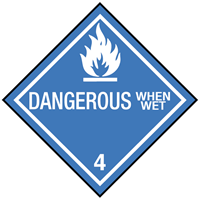
 Print
Print
Chemical Datasheet
ZINC PHENOLSULFONATE |

|
Chemical Identifiers
| CAS Number |
UN/NA Number |
DOT Hazard Label |
USCG CHRIS Code |
|
|
|
|
|
| NIOSH Pocket Guide |
International Chem Safety Card |
|
none
|
none
|
NFPA 704
data unavailable
General Description
A colorless to white crystalline solid which turns pink on exposure to air. The primary is the threat to the environment. Immediate steps should be taken to limit its spread to the environment. It is soluble in water. It is used as an insecticide and in medicine.
Hazards
Reactivity Alerts
none
Air & Water Reactions
Soluble in water. Turns pink on exposure to air.
Fire Hazard
Special Hazards of Combustion Products: Irritating oxides of sulfur may form in fires. (USCG, 1999)
Health Hazard
Inhalation of dust may irritate nose and throat. Ingestion of large doses has emetic and astringent effects; can cause irritation or corrosion of the alimentary tract. Contact with eyes causes irritation. Contact with skin causes mild irritation. (USCG, 1999)
Reactivity Profile
ZINC PHENOLSULFONATE behaves as a weak acid in solution. Therefore, it would react with bases in neutralization reactions that would generate heat.
Belongs to the Following Reactive Group(s)
- Phenols and Cresols
- Salts, Acidic
Potentially Incompatible Absorbents
No information available.
Response Recommendations
Isolation and Evacuation
Excerpt from ERG Guide 138 [Substances - Water-Reactive (Emitting Flammable Gases)]:
IMMEDIATE PRECAUTIONARY MEASURE: Isolate spill or leak area in all directions for at least 50 meters (150 feet) for liquids and at least 25 meters (75 feet) for solids.
LARGE SPILL: Consider initial downwind evacuation for at least 300 meters (1000 feet).
FIRE: If tank, rail tank car or highway tank is involved in a fire, ISOLATE for 800 meters (1/2 mile) in all directions; also, consider initial evacuation for 800 meters (1/2 mile) in all directions. (ERG, 2024)
Firefighting
Excerpt from ERG Guide 138 [Substances - Water-Reactive (Emitting Flammable Gases)]:
DO NOT USE WATER OR FOAM.
SMALL FIRE: Dry chemical, soda ash, lime or sand.
LARGE FIRE: DRY sand, dry chemical, soda ash or lime or withdraw from area and let fire burn. If it can be done safely, move undamaged containers away from the area around the fire.
FIRE INVOLVING METALS OR POWDERS (ALUMINUM, LITHIUM, MAGNESIUM, ETC.): Use dry chemical, DRY sand, sodium chloride powder, graphite powder or class D extinguishers; in addition, for Lithium you may use Lith-X® powder or copper powder. Also, see ERG Guide 170.
FIRE INVOLVING TANKS, RAIL TANK CARS OR HIGHWAY TANKS: Fight fire from maximum distance or use unmanned master stream devices or monitor nozzles. Do not get water inside containers. Cool containers with flooding quantities of water until well after fire is out. Withdraw immediately in case of rising sound from venting safety devices or discoloration of tank. ALWAYS stay away from tanks in direct contact with flames. (ERG, 2024)
Non-Fire Response
Excerpt from ERG Guide 138 [Substances - Water-Reactive (Emitting Flammable Gases)]:
ELIMINATE all ignition sources (no smoking, flares, sparks or flames) from immediate area. Do not touch or walk through spilled material. Stop leak if you can do it without risk. Use water spray to reduce vapors or divert vapor cloud drift. Avoid allowing water runoff to contact spilled material. DO NOT GET WATER on spilled substance or inside containers.
SMALL SPILL: Cover with DRY earth, DRY sand or other non-combustible material followed with plastic sheet to minimize spreading or contact with rain. Dike for later disposal; do not apply water unless directed to do so.
POWDER SPILL: Cover powder spill with plastic sheet or tarp to minimize spreading and keep powder dry. DO NOT CLEAN-UP OR DISPOSE OF, EXCEPT UNDER SUPERVISION OF A SPECIALIST. (ERG, 2024)
Protective Clothing
Dust mask; goggles or face shield; protective gloves (USCG, 1999)
DuPont Tychem® Suit Fabrics
No information available.
First Aid
INHALATION: move to fresh air.
INGESTION: if large amount has been swallowed, induce vomiting, followed by prompt and complete gastric lavage, cathartics, and demulcents.
EYES or SKIN: flush with water. (USCG, 1999)
Physical Properties
Flash Point: data unavailable
Lower Explosive Limit (LEL): data unavailable
Upper Explosive Limit (UEL): data unavailable
Autoignition Temperature: data unavailable
Melting Point: data unavailable
Vapor Pressure: data unavailable
Vapor Density (Relative to Air): data unavailable
Specific Gravity:
greater than 1
at 68°F
(USCG, 1999)
Boiling Point:
248°F
at 760 mmHg
(decomposes)
(USCG, 1999)
Molecular Weight:
555.8
(USCG, 1999)
Water Solubility: data unavailable
Ionization Energy/Potential: data unavailable
IDLH: data unavailable
AEGLs (Acute Exposure Guideline Levels)
No AEGL information available.
ERPGs (Emergency Response Planning Guidelines)
No ERPG information available.
PACs (Protective Action Criteria)
| Chemical |
PAC-1 |
PAC-2 |
PAC-3 |
| Zinc phenolsulfonate; (Zinc p-hydroxybenzenesulfonate) (127-82-2)
|
5.4 mg/m3 |
59 mg/m3 |
360 mg/m3 |
(DOE, 2024)
Regulatory Information
EPA Consolidated List of Lists
| Regulatory Name |
CAS Number/
313 Category Code |
EPCRA 302
EHS TPQ |
EPCRA 304
EHS RQ |
CERCLA RQ |
EPCRA 313
TRI |
RCRA
Code |
CAA 112(r)
RMP TQ |
| Zinc Compounds |
N982 |
|
|
& |
313 |
|
|
| Zinc phenolsulfonate |
127-82-2 |
|
|
5000 pounds |
313c |
|
|
(EPA List of Lists, 2024)
CISA Chemical Facility Anti-Terrorism Standards (CFATS)
No regulatory information available.
OSHA Process Safety Management (PSM) Standard List
No regulatory information available.
Alternate Chemical Names
- BENZENESULFONIC ACID, P-HYDROXY-, ZINC SALT (2:1)
- P-HYDROXYBENZENESULFONIC ACID ZINC SALT
- ZINC P-PHENOLSULFONATE
- ZINC PHENOLSULFONATE
- ZINC PHENOLSULFONATE OCTAHYDRATE
- ZINC PHENOLSULPHONATE
- ZINC SULFOCARBOLATE
- ZINC SULFOPHENATE


 Print
Print
